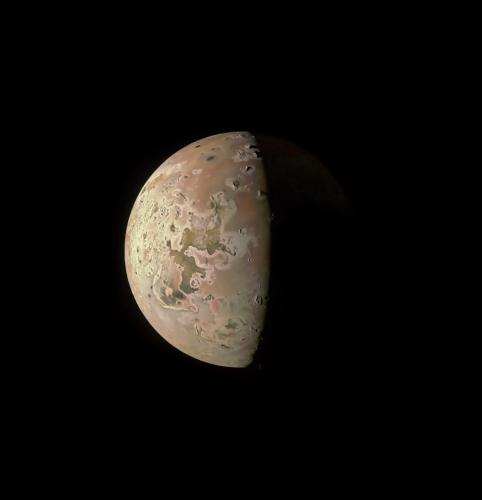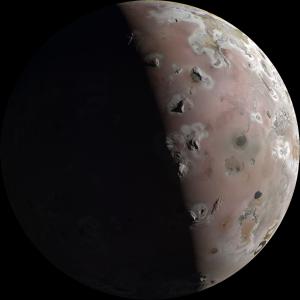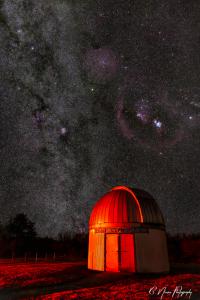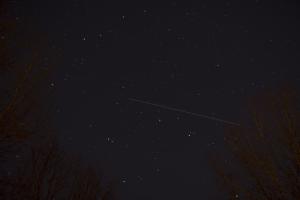Celebration of Space - January 5, 2024

Juno performs successful flyby maneuver of Galilean Moon, Io on December 30, 2023. Image credit: NASA/JPL-Caltech/SwRI/MSSS, Image processing by Ted Stryk
On December 30, 2023, the NASA Juno spacecraft, which has been orbiting and studying Jupiter for the past several years, performed a close flyby of the Galilean Moon Io. During this flyby some of the best images of the volcanic moon were captured. Here is the highest resolution image that was captured by Juno.
Io is a moon that is stuck in an endless tug of war with Jupiter and the other three Galilean Moons. This stretching and compressing activity results in the heating of Io’s mantle and core, where portions of these regions melt. As such, Io is the most geologically active body in the Solar System. The landscape is dominated by volcanoes with eruptions that reach 300 miles in the sky. These eruptions spew sulfur ash and huge lava flows onto the surface. Io measures 2,264 miles in diameter and orbits Jupiter at an average of 262,873 miles distant. Which is quite similar to Earth’s Moon, which measures 2,159 miles in diameter, and orbits Earth at an average distance of 238,000 miles. This places Io as the fourth largest moon in the Solar System, just before Earth’s Moon.
In the image, north is at the top. The terminator, which is the line that separates the illuminated and dark regions, passes vertically through the center of the image. Even though the night side is dark, it is still slightly visible due to sunlight reflecting off of Jupiter. The white regions in the image are sulfur dioxide frost, and the colorful regions show a higher concentration of sulfur. You may notice that the surface is quite devoid of impact craters, which is due to the high amount of active geology that occurs on Io. This keeps the surface relatively new. At the top right and bottom center of the image are three notable eruption plumes which create a red fan-like ring. These are associated with large volcanic vents of degassing lava. At the very bottom right edge of the image is Loki Patera (looks like a black reversed letter C), which is a volcanic depression (lava lake) that measures 126 miles in diameter. Just above Loki Patera is another dark region, this is the Amaterasu Patera volcanic crater. Just above that is the larger Dazhbog Patera, which is another volcanic caldera.
Take some time to browse the image, then stop in at NASA’s Juno website to catch up on the mission and perhaps check out some of the other fabulous images that have been captured by Juno.
This coming Thursday, January 11, 2024 at 6:58 am EST, the first New Moon of 2024 will occur. This happens when the Moon orbits into a position around Earth where the Sun is on the opposite side of the Moon than Earth. We call this “opposition”, and it will place the Moon into the daytime sky for the entire day. During the new Moon, we only see the nighttime side of the Moon, and the Moon will be located very close to the Sun in the daytime sky. Consequently, the night of the new Moon will bring the darkest night of the 29.5 day lunar synodic period. A perfect opportunity to get out and stargaze. The nights following the new Moon will bring a stunning waxing crescent Moon to the dusk and twilight sky, which is well worth a view. Additionally, the days before the new Moon will bring the super thin waning crescent to the predawn morning sky for those who are making the early commute. Over the next week, be sure to set aside a time to check out either crescent phase, you won’t be disappointed.
This evening, Friday, January 5, 2024, the Starlink constellation, which launched on January 3rd, will be passing over our region. Starlink satellites are only visible for a couple of days after launch, and appear as a train of satellites moving across the sky. Tonight’s view of Starlink will pass directly overhead for sky watchers in the Northeast. If you haven’t seen a Starlink constellation pass, you are certainly missing out, as it is quite a unique view. To see the pass, you need to be outside and at a location with a good view of the night sky, preferably with the least amount of light pollution possible, though this pass may be bright enough to be dimly seen under a heavy light polluted sky. Be outside and ready by 5:39 pm, look to the NW sky and wait for a minute or so. You will start to notice dim satellites in a line following each other towards the zenith (top of the sky), which will continue towards the SW horizon. The entire pass should last about 5 minutes. Regardless if you are out with your family, friends, or just yourself, this is an excellent opportunity to catch a view. Let us know if you see them.
This coming Monday, January 8, 2024, the China National Space Administration (CNSA) Tiangong station will resume daily evening passes over the United States. Evening passes are the easiest to see because they happen during a time that everyone is usually at home and awake. Over the past few years the Tiangong station, which is modular, has expanded to be nearly the size of the International Space Station (ISS), so catching a view is very easy because it is quite bright. Evening passes of Tiangong will continue daily until January 22, 2024. Here are some notable pass times for the coming week:
Tue, Jan 16 at 5:27 pm, starting in the W, rising to 85º, heading towards the E, and into orbital sunset ← Awesome pass!
Wed, Jan 17 at 5:59 pm, starting in the W, rising to 79º, heading towards the ESE, and into orbital sunset ← Awesome pass!
Thu, Jan 18 at 6:32 pm, starting in the W, rising to 42º, and into orbital sunset
Note that these passes are applicable to Southern New England, but will be usable for the entire Northeast. For daily pass times of Tiangong and other bright satellites over our region, visit the Frosty Drew Daily Satellite Pass Prediction Utility. Also, if you have a suggestion for a better name for that utility, please let us know by responding to this email.
Stay safe this weekend and coming week with the weather systems moving into our region, and take a moment to enjoy the first big snow of the year, if you are in the accumulation zone.
- Author:
- Scott MacNeill
- Entry Date:
- Jan 5, 2024
- Published Under:
- Scott MacNeill's Columns




